
If you own or work with a healthcare organization, it’s probably because you want to focus on actually providing healthcare services to your patients. This means any time spent worrying about keeping your systems HIPAA compliant or protecting data from possible breaches takes you away from this goal.
Unfortunately, thinking about technology is just one piece of the puzzle. Regardless of the size of your organization, you probably also run into administrative bottlenecks, resource limitations, and rising costs, all of which further prevent you from delivering the level and quality of service you want to provide your patients.
And if this wasn’t enough to give you a rush of anxiety, your patients are probably expecting more from you than ever before.
Microsoft Teams can help. Office 365 has a whole slew of tools to help many types of teams be more successful, but here we’ll walk through the capabilities of Microsoft Teams that allow healthcare providers to be better at what they want to do—which is keeping patients healthy and safe.
Use Microsoft Teams to Provide Virtual Care to Patients
The traditional healthcare model, where healthcare providers wait for patients to physically come to them, is quickly becoming outdated. 62% of patients now feel comfortable being consulted by healthcare providers over phone or email according to Deloitte’s 2016 Global Health Care Outlook Research.
Even more telling is that 75% of patients worldwide expect to start using these kind of digital health services in the near future according to the McKinsey Digital Patient Survey of 2014. Remember when I said, “your patients are probably expecting more from you than ever before”? Turns out it’s not just probable; it’s true. And, it’s not only young people interested in these services. This survey also found that patients over 50 were just as interested in digital healthcare services as younger patients.
Technology has impacted nearly every aspect of life, and consumers have come to expect intuitive experiences and streamlined processes. If you’re a healthcare provider not already offering digital services, you are missing out on a wealth of opportunities to provide more value for your patients.
Microsoft Teams can help you meet these rising expectations.
Easily Video Conference with Patients on Teams
When it comes to digitally meeting with your patients, using Microsoft Teams means you don’t have to worry about the daunting task of setting up a digital care system that works for anyone and is also compliant. Microsoft has already done this work for you.
You can send anyone with an email address an invitation to a Microsoft Teams Meeting that includes HD video capabilities. Your patients can join from the comfort of their own home, and all they need is a browser, which means no annoying plugin or application downloads. On-the-go patients or providers can also join from their phones for a full audio and video experience.
Blur Your Background to Prevent Unwanted Data Broadcasting
Teams also helps you keep protected health information (PHI) secure while on video calls by allowing you to blur the background of your video. This keeps patients focused on you and prevents any data displayed around you—maybe other patient files sitting near you—from being broadcasted in your meetings.

Use Teams to Communicate Efficiently and Compliantly with Colleagues
Microsoft Teams is also HIPAA compliant, delivering Microsoft’s signature compliance and security capabilities like eDiscovery, legal hold, two-factor authentication, and full data encryption.
Data Loss Prevention policies can monitor your entire Teams environment from private one-on-one chats to channel communications between larger teams to identify, monitor, and automatically protect sensitive information. These policies can prevent credit card numbers, social security numbers, or health records from being shared unintentionally.
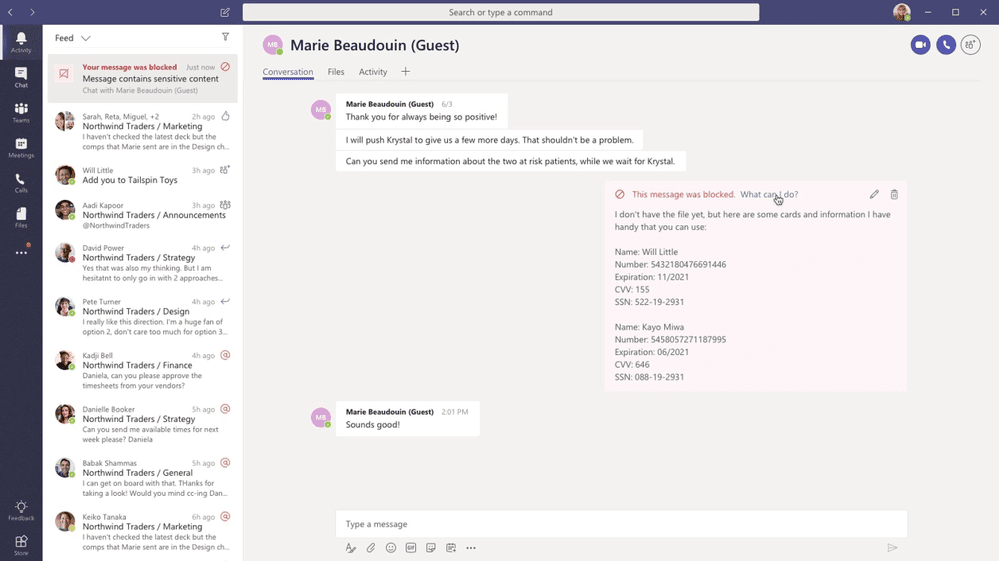
This means anything that happens in Microsoft Teams is compliant and protected. You never have to worry about data existing on consumer chat applications your team might be using to facilitate communication or PHI being shared inappropriately.
Secure Image Annotation and Chat
As the expected pace of healthcare increases, Microsoft Teams allows clinicians to securely and quickly share insights with other team members.
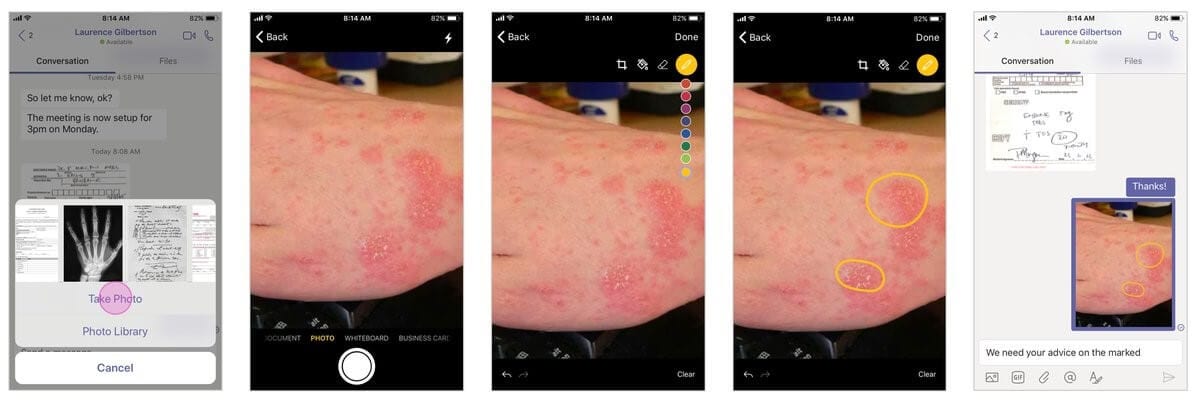
In an industry where actually seeing the problem can be integral to providing accurate care, you can use secure image annotation and chat to get answers from colleagues fast—without the possibility of private information being exposed. Secure Image Annotation—like everything in Teams—is HIPAA compliant, and IT Admins can help further protect your data by preventing images from being stored on mobile devices or local drives—a HIPAA violation.
Meet Online for Efficient and Effective Care Decisions
Sometimes providers need to consult other experts in more formal ways or get input from a larger number of individuals before making care decisions. When this happens, you can use Teams meetings for more in-depth conversations.
Just like with patients, anyone with an email address can join for the full audio and video experience. You can record these meetings for future reference, and recordings are searchable, so you never lose track of vital information.

Need to look at a file or examine a patient record while on a meeting? Sharing content in Teams is easy. Anyone on the call can share a specific file or their entire screen, so your group has everything they need all in one place to make effective and timely care decisions.
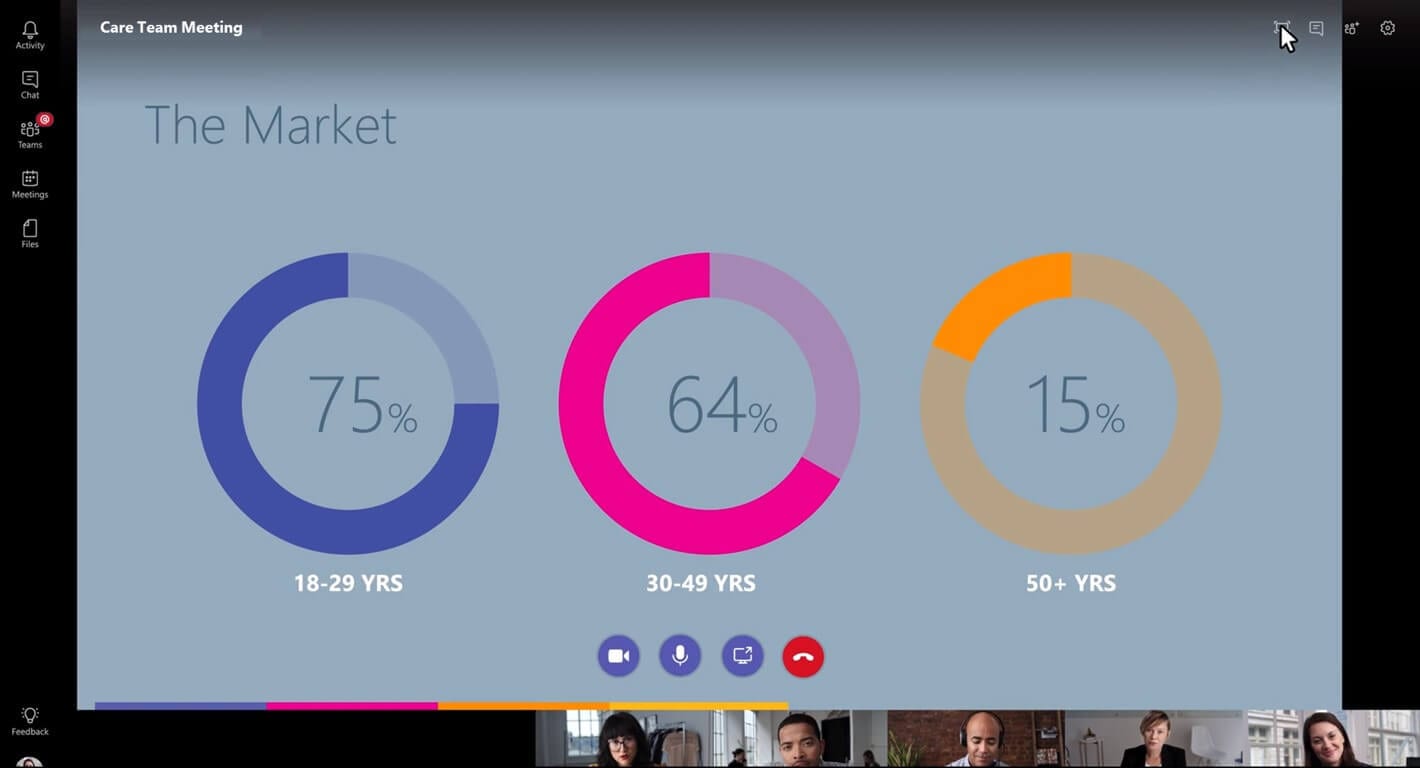
Urgent Notifications
Let others know when your message—and your patient—needs urgent attention. When you mark a message as urgent, recipients will automatically be notified every two minutes until they check the message (up to twenty minutes) and will see the below red urgent banner on their screen until they check the message.

Store Patient Files in One Easily Accessible Place
With Microsoft Teams, each workspace gets its own dedicated SharePoint site. What’s the best thing about SharePoint Online? You guessed it; it’s HIPAA compliant and features its own robust set of encryption and information protection features. When you store all your materials in Office 365 and Microsoft Teams, you can rest assured they’re always protected.
Collaborate on Up-to-Date Information
Clinicians need more efficient and secure access to clinical systems with a reduced amount of paperwork to fill out. Make it easy for your care teams to share and manage documents. Microsoft Teams gives you a few clear benefits in this area:
Documents can be accessed securely where ever your team members are working
With Office 365 Applications like Microsoft Teams and SharePoint on your phone and secure access to Office 365 via any browser, you don’t have to be at your desk to reference the information you need to make critical decisions. Your files are available to you wherever you have an internet connection.
Access current documents that are updated in real time
Ever been stuck emailing copies of a document back and forth, trying to compile edits, and then not being sure which document is the most current version? This is an especially compelling problem for medical offices where having the latest data is crucial for making care decisions. Office 365 and Microsoft Teams get rid of this problem. Anybody can work on documents in Teams—at the same time and with real-time updates—so you never have to worry you’re not seeing the most up-to-date file.
Medical teams can have persistent, focused conversations about files
In Microsoft Teams, you can open a conversation that is persistent and focused. This means that your conversation lives with the document whenever someone opens it in Teams. Maybe you’re looking at a patient’s file and need to ask their primary care physician about a test result. Open a connected chat window with the document and your question and the answer will be visible to anyone who views the document in the future—which is sure to save that primary care physician some time answering the question over and over again for other colleagues.
But don’t worry about your chats always being accessible to others. Open a separate one-on-one chat to ask questions you don’t want connected to files and be confident your conversation is private.
All of a single patient’s documents live in a single space for easy access
Teams allows you to keep files organized. You’ll never need to search in multiple places for a single patient’s files. Compile lab results, clinician notes, and more in one secure location.
Give Patients Access to Their Data
HIPAA and the Health Information Technology for Economic and Clinical Health (HITECH) Act, give your patients the right to control the use and disclosure of their personal information. Microsoft Teams can bring transparency to this process. Give your patients guest access and visibility to their own data, while still maintaining control and compliance. Guests will only be able to see the data you allow, and they won’t be able to change or download anything without permission.
Further Ramp Up Productivity with Microsoft Teams App Integrations
Microsoft Teams allows you to integrate your most important systems or take advantage of other helpful third-party apps.
Care Coordination Templates
Care Coordination Templates are currently in private preview but will be released soon for general use in Microsoft Teams. Essential time is wasted when healthcare professionals must gather information from across your EMR or EHR system. To help solve this problem and get your team back to serving patients, Teams can integrate with these systems to bring all the necessary data into one place for easy, immediate access that reduces administrative overhead.
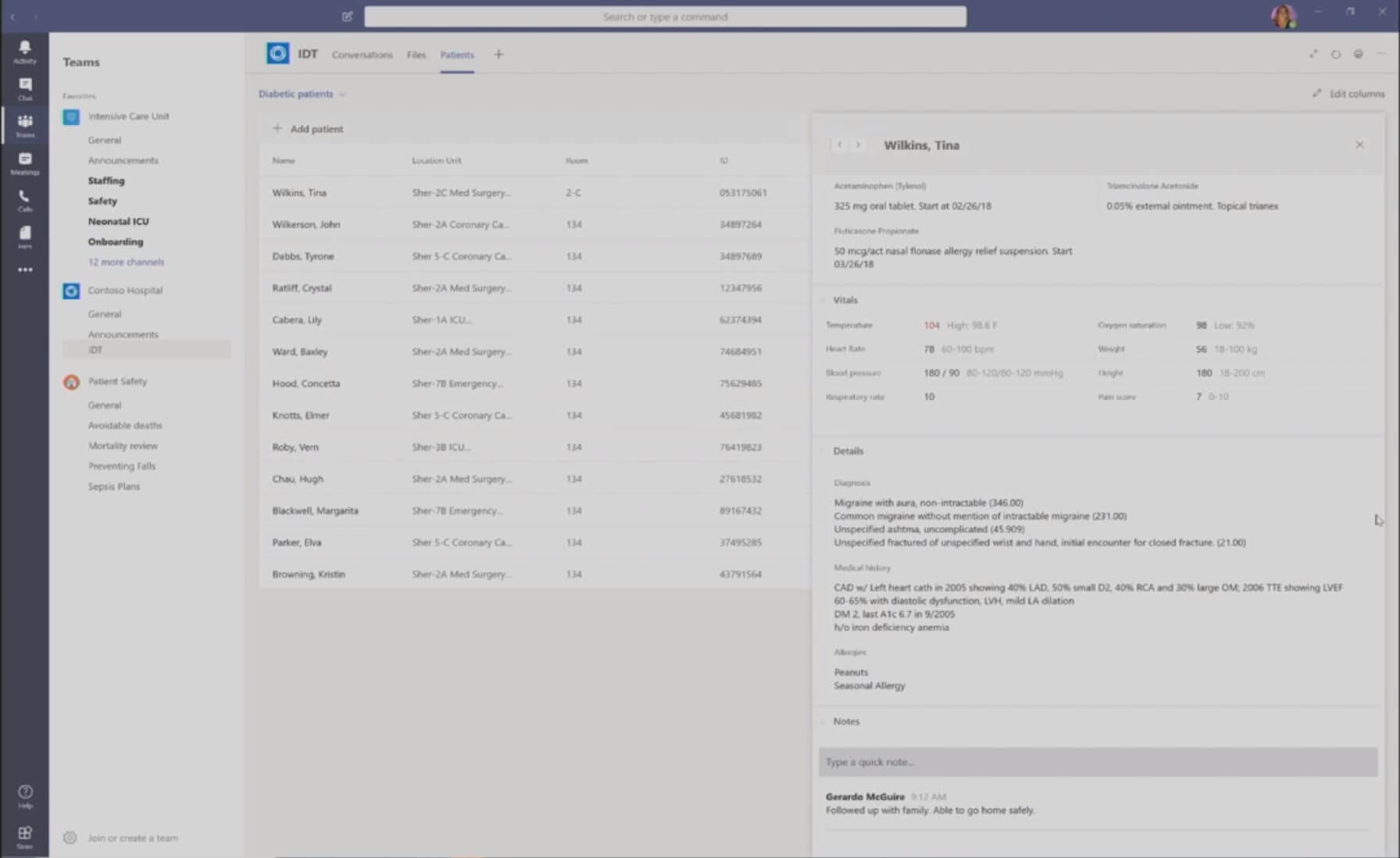
Add your patients to lists in relevant Teams, so providers can access all of their associated information with one click. Teams serves up-to-date information to your clinicians directly from your EHR system, and team members can leave notes to let other clinicians know what’s happening with their patients. This way, your care team can quickly see and share relevant patient information, have accountability and real time updates on action items, and effectively coordinate care delivery.
All of this functionality will also be available from mobile, so busy providers and on-the-go clinicians will always have access to this data.
Adaptive Cards in Office 365
Using the Microsoft Teams Development platform and Adaptive Cards in Microsoft Teams gives you even further integration with your EHR System. Just like with Care Coordination templates, Adaptive Cards allow you to search and find data in your EHR system with just a few clicks. You can build cards to pull the data your Teams environment needs access to most often or automate the processes your team spends too much time on.
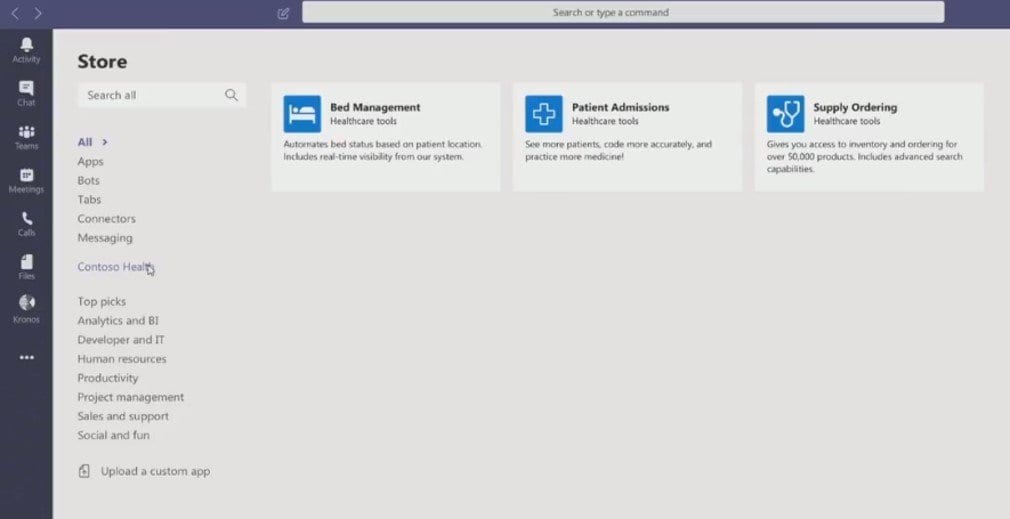
Microsoft Teams Keeps You Focused on Your Patients
Microsoft Teams offers so many tools to help Healthcare teams focus on patient care. Microsoft is also always working to expand its capabilities, offering more specialized tools like Care Coordination templates to help many different types of teams increase their effectiveness.
With patient expectations continuing to rise and protected health information a primary target for malicious attacks, it’s more important than ever to make sure your team is supported by a HIPAA-compliant, digital care system that works for your business and your patients.
By making it easier for clinical staff to keep track of their patients, connect with team members and specialists, and provide virtual care, you can help your teams be more productive, more effective, and more satisfied with their work.
Stephanie Hamrick, PEI




